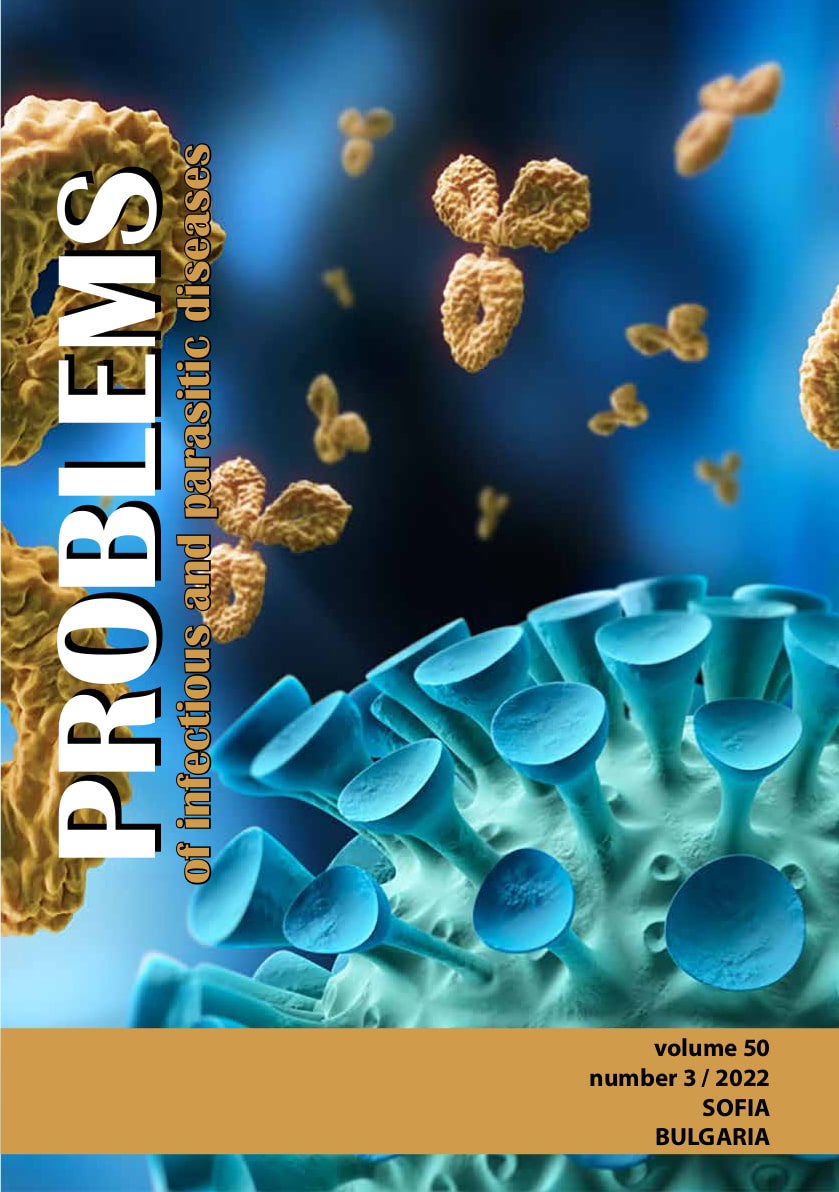HEALTHCARE WORKERS IN BULGARIA - ARE THEY PROTECTED FROM VACCINE-PREVENTABLE INFECTIONS?
DOI:
https://doi.org/10.58395/sqx8py36Keywords:
HCWs, measles, mumps, rubella, IgG immunityAbstract
Background: Healthcare workers (HCWs) are at increased risk of exposure to many viral infections, including vaccine preventable diseases (VPDs) such as measles, mumps and rubella (MMR) as compared to non-HCWs. Immunity of HCWs against these viruses is mandatory in a healthcare setting due to possible exposure from patients or colleagues.
Aim: To provide an assessment of anti-measles, mumps and rubella IgG seropositivity among Bulgarian HCWs employed in hospitals and regional health inspectorates (RHI), as an indicator of protective immunity against MMR in this risk group.
Materials and Methods: In the current study, 181 HCWs from Infectious Units in regional hospitals in the country, and HCWs from the RHI, involved in the monitoring and surveillance of MMR cases in Bulgaria were screened. Serum specimens from all participants were tested by a commercial indirect enzyme-linked immunosorbent assay (Anti-Measles, Anti-Mumps, Anti-Rubella IgG EIA-Euroimmun®, Germany) for presence of IgG antibodies against measles, mumps and rubella, as an indicator of protective immunity.
Results: The study included 181 HCWs, 25 male and 156 female, aged 22 to 66 years. The average protective seroprevalence for measles, mumps and rubella was 82.9%, 76.2% and 92.3% percent, respectively. The highest share of negative results were obtained for mumps-specific IgG – 23.2% (42/181), followed by measles 16.6% (60/181) and rubella-specific IgG 7.7% (19/181). Regarding the age distribution, the highest number of HCWs non-immune to measles and mumps was found among the 31- 40-year olds, and against mumps – among the 41-50-year-olds.
Conclusion: HCWs are at greater risk of contracting infections than the general population because of contact with sick patients or infectious material. Infected healthcare workers can spread nosocomial diseases to vulnerable patients with more severe illness, leading to complications and even death. Therefore, the vaccination status of HCWs must be strictly monitored.
Downloads
References
Kofi, Mostafa; Rasheed, Abdulaziz Bin; AlBattal, Saad; Al Abood, Abood; Alshowair, Abdulmajeed; AlQahtani, Abdulaziz; Selim, Mohie; Yousef, Yasser; ElSaid, Tarek; Alkhalifah, Abdulrahman. Measles, Mumps, Rubella, and Varicella Immunity among Nursing Staff in a Major Hospital, Riyadh, Saudi Arabia. Journal of Family Medicine and Primary Care 9(10):p 5339-5344, October 30, 2020. https://doi.org/10.4103/jfmpc.jfmpc_906_20
Alp E, Cevahir F, Gökahmetoglu S, Demiraslan H, Doganay M. Prevaccination screening of health-care workers for immunity to measles, rubella, mumps, and varicella in a developing country: What do we save? J Infect Public Health. 2012; 5:127–32. https://doi.org/10.1016/j.jiph.2011.11.003
Centers for Disease Control and Prevention: Vaccine side effects, adverse reactions, contraindications, and precautions, recommendations of the advisory committee on immunization practices (ACIP). MMWR Recomm. Rep. 1996; 45:1–35
Wicker S., H.C. Maltezou. Vaccine-preventable diseases in Europe: where do we stand? Expert Rev Vaccines, 2014, pp. 979-987. https://doi.org/10.1586/14760584.2014.933077
Alp E., Cevahir F., Gokahmetoglu S., Demiraslan H., Doganay M. Prevaccination screening of health care workers for immunity to measles, rubella, mumps and varicella in a developing country. What do we save? BMC Proc, 5, 2011. https://doi.org/10.1186/1753-6561-5-s6-p277
World Health Organization. Eliminating measles and rubella and preventing congenital rubella infection. WHO European region strategic plan 2005-2010.
European Commission. Commission Implementing Decision of 8 August 2012 amending Decision 2002/253/EC laying down case definitions for reporting communicable diseases to the Community network under Decision No 2119/98/EC of the European Parliament and of the Council. Luxembourg: Publications Office of the European Union. L262 Sep 27, 2012. Available from: http://eur-lex.europa.eu/legal-content/EN/TXT/?uri=OJ%3AL%3A2012%3A262%3ATOC
Ministry of Health of Bulgaria. [Ordinance 21/18.07.2005 on the procedure for registration, notification and reporting of communicable diseases]. State Gazette. 2005; Bulgarian. Available from: http://lex.bg/en/laws/ldoc/2135508238
https://www.cdc.gov/vaccines/adults/rec-vac/hcw.html
Vagholkar S, et al. Healthcare workers and immunity to infectious diseases. Australian and New Zealand Journal of Public Health, 2008; 32: 367-371. https://doi.org/10.1111/j.1753-6405.2008.00257.x
Fedeli U, Zanetti C, Saia B. Susceptibility of healthcare workers to measles, mumps rubella and varicella. Journal of Hospital Infection, 2002; 51: 133–135. https://doi.org/10.1053/jhin.2002.1222
Celikbas A, et al. Measles, rubella, mumps, and varicella seroprevalence among health care workers in Turkey: is prevaccination screening cost-effective? American Journal of Infection Control, 2006; 34: 583–587. https://doi.org/10.1016/j.ajic.2006.04.213
Almuneef MA, et al. Seroprevalence survey of varicella, measles, rubella, and hepatitis A and B viruses in a multinational healthcare workforce in Saudi Arabia. Infection Control and Hospital Epidemiology, 2006; 27: 1178–1183. https://doi.org/10.1086/508826
Hatakeyama S, et al. Prevalence of measles, rubella, mumps, and varicella antibodies among healthcare workers in Japan. Infection Control and Hospital Epidemiology, 2004; 25: 591–594. https://doi.org/10.1086/502444
Asari, S., Deguchi, M., Tahara, K., Taniike, M., Toyokawa, M., Nishi, I., Watanabe, M., Iwatani, Y., & Makimoto, K. Seroprevalence survey of measles, rubella, varicella, and mumps antibodies in health care workers and evaluation of a vaccination program in a tertiary care hospital in Japan. American journal of infection control, 2003, 31(3), 157–162. https://doi.org/10.1067/mic.2003.16
Kumakura S, Shibata H, Onoda K, Nishimura N, Matsuda C, Hirose M. Seroprevalence survey on measles, mumps, rubella and varicella antibodies in healthcare workers in Japan: sex, age, occupational-related differences and vaccine efficacy. Epidemiol Infect. 2014; 142(1):12-9. doi: 10.1017/S0950268813000393. Epub 2013 Apr 11. PMID: 23574767; PMCID: PMC3857110.
Kurchatova A, Krumova S, Vladimirova N, Nikolaeva-Glomb L, Stoyanova A, Kantardjiev T, Gatcheva N. Preliminary findings indicate nosocomial transmission and Roma population as most affected group in ongoing measles B3 genotype outbreak in Bulgaria, March to August 2017. Euro Surveill. 2017;22(36):pii=30611. http://dx.doi.org/10.2807/1560-7917.ES.2017.22.36.30611
Downloads
Published
Issue
Section
License
Copyright (c) 2023 Radostina Stefanova, Petia Genova-Kalou, Ivona Andonova, Maria Pishmisheva-Peleva, Stefka Krumova (Author)

This work is licensed under a Creative Commons Attribution 4.0 International License.





